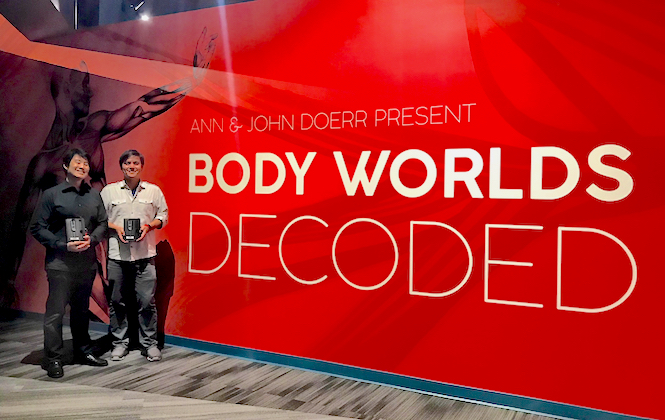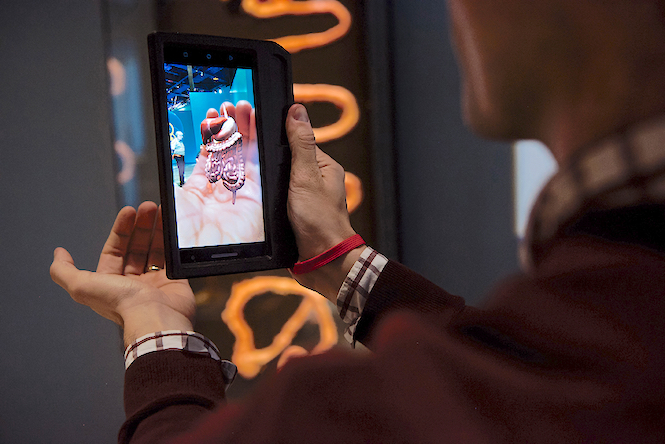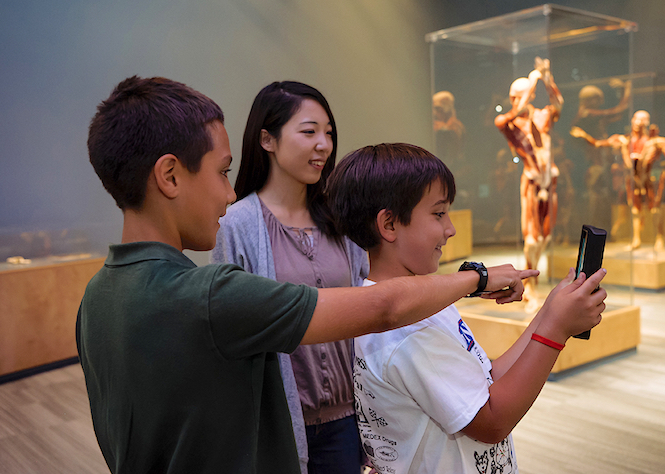Future Now
The IFTF Blog
Augmented Reality: Empowering the Future of Museums

As Director of the Emerging Media Lab at Institute for the Future, I spend my days researching, exploring, and experimenting with the latest communication and media technologies. For the past year, building on a long-term partnership, my team in the IFTF EML and The Tech Museum of Innovation team set out to create one of the world’s first, custom augmented reality (AR) experiences for the world-renowned Body Worlds Decoded exhibit. The result is an entirely new AR content authoring and management software solution, called ARtifactorTM that enables The Tech to customize and rotate new content for the exhibit’s new AR Iris system. Over time, The Tech will use ARtifactorTM to add 3D models, animations, and other content to the exhibition, so visitors will always have something new to discover.
What exactly is AR?
Augmented Reality (AR) is a less known, but related technology to Virtual Reality (VR). Over the last year there has been considerable excitement around the release of VR technologies, such as HTC Vive and Facebook’s Oculus Rift, and for good reason. After decades of VR being relegated to expensive aerospace laboratories and science fiction movies, consumers are now able to purchase powerful VR systems for their home and office that enable them to enter into virtual worlds and immersive experiences.
In the past few months we are now seeing the emergence of a new and related technology, Augmented Reality (AR) slowly move from science fiction to science fact. The ambient computer interfaces we’ve seen in movies like Iron Man and Minority Report will soon be every day experiences for many of us in both our personal and professional lives.
While VR systems completely block out the real world and replace it with a virtual simulated environment, AR allows users to continue to see the real world while overlaying virtual objects, characters, and information on top of the real world.
Even though there are some obvious differences between VR and AR, both essentially use tracking technologies to overlay 3D visualizations. This allows us to view and interact with information and virtual objects in “immersive” (VR) and “ambient” (AR) computing interfaces.
Recently both Apple and Google have introduced basic AR capabilities into their mobile OS’s allowing users to track the world through the onboard cameras and overlay 3D visualizations to both their world and themselves. Even computer giants, Intel and Microsoft are rebranding themselves as AR centric computing companies.
Applications
PokemonGo has probably been the most famous AR application to date where virtual characters were overlaid on top of people’s real world neighborhoods and backyards. Snapchat “Filters” are also a very popular form of AR where virtual costumes are overlaid on top of users faces using facial tracking technology.
Right now, most AR applications are for fun and games, but powerful AR applications are being developed for industrial, healthcare, creative and educational uses. Imagine walking through a factory where you can see real time performance data from every piece of machinery. Imagine a surgeon who is able to overlay a patient’s 3D MRI on top of their body as they are operating on them. Imagine a world overlaid with artistic and educational layers of information and objects.
Museums in particular offer a wide range of powerful applications for AR and are about to radically change the very definition of what a “museum” is. At their core, museums are essentially collections of interesting objects with a narrative layer applied on top. With AR, the entire world is about to become the ultimate museum layered with information, visualizations and stories that help us see deeper into the history, makeup and meaning of the world we live in.

The IFTF ARtifactorTM Content Development Platform
Our ARtifactor content development platform enables museums like The Tech Museum to create a layer of augmented exhibits that wrap around the physical exhibits such as the BodyWorlds Decoded exhibition. ARtifactor powers The Tech Museum’s AR Iris devices (which also leverage Google’s “ARcore/Tango” technology).
Our ARtifactor software allows museum exhibit designers to design AR exhibits, place them in the physical spaces, link relevant additional media content like photos and videos, all through a simple, user-friendly interface exhibit designers are able to create and quickly iterate AR exhibits without the need for a computer programmer or software engineer.
Visitors check out the AR enabled “Iris” tablets as soon as they enter the Bodyworlds Decoded exhibit. As they walk through the exhibit hall they will be able to explore virtual 3D animations of various anatomical systems such as a giant moving eye, a collection of flowing blood cells, and animated digestive tract. Visitors will also be able to access additional content, photos, and videos related to both the virtual and physical exhibits via ARtifactor’s “Content Window” which is triggered by hotspot links that are placed in 3D space around each exhibit.

We are very excited to be launching BodyWorlds Decoded with our partners The Tech Museum, Google, and Stanford Clinical Anatomy Lab. This will likely be many visitors first experience with AR and we are looking forward to working with The Tech Museum to continue to develop new AR experiences, both inside and outside of the museum. And we are thrilled that the IFTF ARtifactor AR platform will continue to enable this AR exhibit to inspire the wonder and imagination of visitors to Body Worlds Decoded.
Meanwhile ARtifactor has the potential to be a powerful toolset for the development of other AR experiences both in IFTF’s emerging media research lab and with other partners.
We are at the beginning of an exciting new age of Immersive and ambient media where we will be stepping inside our ideas and designs and turning the world into an interactive learning and communication interface like nothing we’ve seen before.
About IFTF and the EML
Institute for the Future is a non-profit, independent research organization that has spent the past five decades helping large organizations think about long term futures. The Emerging Media Lab at IFTF focuses on the future of communication and collaboration.
For more information contact: [email protected]



